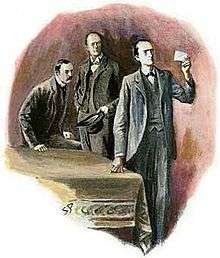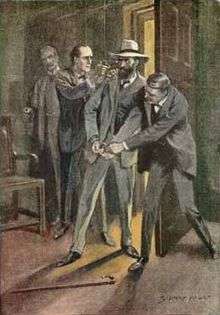The Adventure of the Dancing Men
| "The Adventure of the Dancing Men" | |
|---|---|
 Holmes examining the drawing, 1903 illustration by Sidney Paget | |
| Author | Arthur Conan Doyle |
| Series | The Return of Sherlock Holmes |
| Publication date | 1903 |
"The Adventure of the Dancing Men", a Sherlock Holmes story written by British author Sir Arthur Conan Doyle, is one of 13 stories in the cycle published as The Return of Sherlock Holmes. Doyle ranked "The Adventure of the Dancing Men" third in his list of his twelve favorite Holmes stories. This is one of only two Sherlock Holmes short stories where Holmes' client dies after seeking his help. The other is "The Five Orange Pips", part of The Adventures of Sherlock Holmes.
Synopsis
The story begins when Hilton Cubitt of Ridling Thorpe Manor in Norfolk visits Sherlock Holmes and gives him a piece of paper with the following mysterious sequence of stick figures.
Cubitt explains to Holmes and Dr. Watson that he has recently married an American woman named Elsie Patrick. Before the wedding, she had asked her husband-to-be never to ask about her past, as she had had some "very disagreeable associations" in her life, although she said that there was nothing that she was personally ashamed of. Their marriage had been a happy one until the messages began to arrive, first mailed from the United States and then appearing in the garden.
The messages had made Elsie very afraid but she did not explain the reasons for her fear, and Cubitt insisted on honoring his promise not to ask about Elsie's life in the United States. Holmes examines all of the occurrences of the dancing figures, and they provide him with an important clue - he realizes that it is a substitution cipher and cracks the code by frequency analysis. The last of the messages causes Holmes to fear that the Cubitts are in immediate danger.
Holmes rushes to Ridling Thorpe Manor and finds Cubitt dead of a bullet to the heart and his wife gravely wounded from a gunshot to the head. Inspector Martin of the Norfolk Constabulary believes that it is a murder-suicide attempt; Elsie is the prime suspect. But Holmes, after noting some inconsistencies in that theory, proves that there is a third person involved.
Holmes writes a message — in dancing figure characters — and has it delivered to a lodger at a nearby farm. While waiting for the result of this message, Holmes explains to Watson and Inspector Martin how he cracked the code of the dancing figures. The last message, which caused Holmes and Watson to rush to Norfolk, read "ELSIE PREPARE TO MEET THY GOD".

The lodger, Abe Slaney, another American, unaware that Elsie is gravely wounded, arrives at Ridling Thorpe Manor and is seized as he comes through the door. Holmes had sent for Slaney using the dancing men, knowing that Slaney would believe the message is from Elsie. Slaney reveals that he had been engaged to Elsie, the daughter of the Chicago crime boss that Slaney works for, and that she had fled to escape her old life. Slaney had come to England to get her back. When Slaney and Elsie were speaking through a window, Cubitt had appeared and shots were exchanged; Cubitt was killed and Slaney had fled. Apparently, Elsie then shot herself. Slaney is arrested and sentenced to hang, but his sentence is reduced to penal servitude because Cubitt had fired the first shot. Elsie recovers from her injuries, and spends her life helping the poor and administering her late husband’s estate.
Adaptations
- Eille Norwood starred as Holmes in the 1923 film The Mystery of the Dancing Men.[1]
- The 1943 film Sherlock Holmes and the Secret Weapon, starring Basil Rathbone as Holmes, is credited as an adaptation of "The Dancing Men," but the only element of Doyle's story to be used is the dancing men code. The plot involves Holmes and Professor Moriarty, in a World War II setting, racing to find the pieces of a new bomb sight.[2]
- "The Dancing Men" was adapted for the second episode of the second season of the 1965–68 TV series Sherlock Holmes starring Peter Cushing as Holmes.[3]
- "The Dancing Men" was adapted for the second episode of the 1984 TV series The Adventures of Sherlock Holmes starring Jeremy Brett In this adaptation, the location of Ridling Thorpe Manor is moved from Norfolk to Derbyshire.[4]
- "The Dancing Men" was dramatised for BBC Radio 4 in 1993 by Bert Coules as part of his complete radio adaptation of the canon, starring Clive Merrison as Holmes and Michael Williams as Watson, and featuring Peter Tuddenham as Inspector Martin and Christopher Good as Hilton Cubitt.[5]
- "The Dancing Men" inspired the eleventh episode of the 1999 animated TV series Sherlock Holmes in the 22nd Century.[6]
- "The Adventure of Henry Baskerville and a Dog", an episode of the NHK puppetry Sherlock Holmes is based on "Hound of the Baskervilles" and "The Dancing Men". In it, Holmes deciphers the code found in the school in parallel with investigating the real figure of "Monster Dog".
- In the BBC series Sherlock:
- "The Dancing Men" inspired the second episode of series 1, entitled "The Blind Banker", where ciphers are a prominent feature.
- "The Dancing Men" case itself is directly portrayed at the end of the third and final episode of series 4, entitled "The Final Problem", where the identical "AM HERE ABE SLANEY" cipher is shown.
References
- ↑ The Mystery of the Dancing Men (1923) - IMDb
- ↑ Sherlock Holmes and the Secret Weapon (1943) - IMDb
- ↑ "Sherlock Holmes" The Dancing Men (TV episode 1968) - IMDb
- ↑ IMDb - "The Adventures of Sherlock Holmes" The Dancing Men (TV episode 1984)
- ↑ Bert Coules. "The Return of Sherlock Holmes". The BBC complete audio Sherlock Holmes. Retrieved 12 December 2016.
- ↑ "Sherlock Holmes in the 22nd Century" The Adventure of the Dancing Men (TV episode 1999) - IMDb
External links

